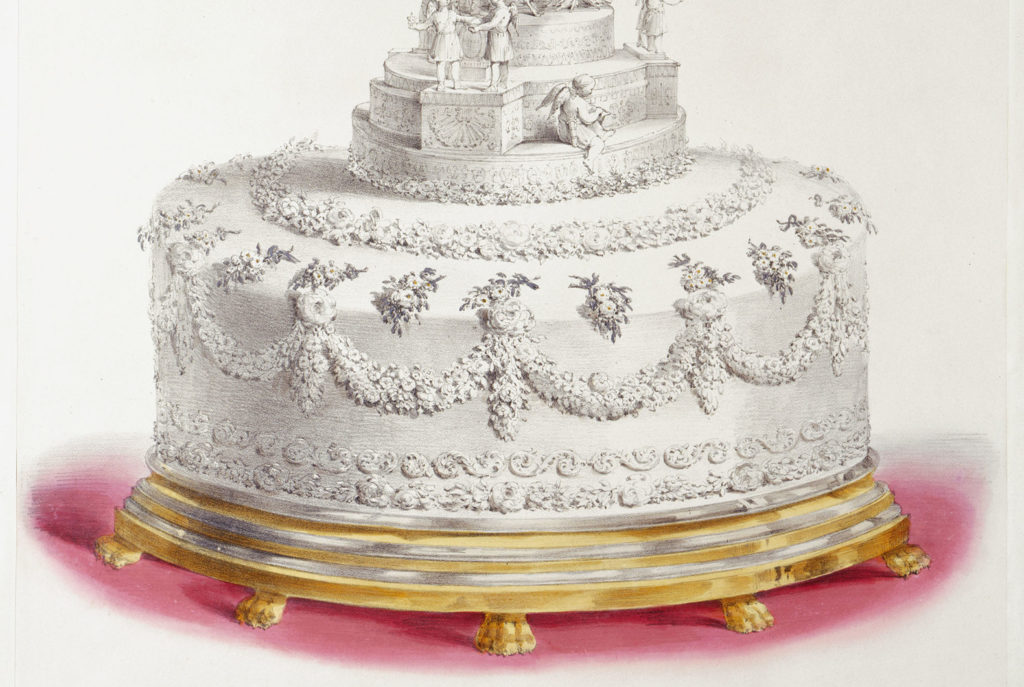Have: a piece of cake.
It’s….pleasantly aged?
Ask: is it past its sell-by date?

According to the BBC, last week a slice of cake from the 1981 wedding of Prince Charles and Princess Diana sold for £1,850 at auction (about $2,500 USD). A piece of one of the couple’s twenty-three cakes, the slice had been in the care of one of the queen mum’s household, who had apparently cocooned it in cling wrap and stored it in a floral tin with a “handle with care” label before selling it to a collector in the early oughts. This person decided the wedding’s 40th anniversary was the perfect occasion to give this slice of cake something cakes don’t usually get: a third owner.
Forty-year-old cake may seem like a very strange souvenir, even if it does happen to be royal cake. But this is hardly the first time the preserved desserts of the rich and famous have been hot commodities.
Wedding cakes as we think of them today in the West are a reasonably recent invention. Emily Allen writes that, at the beginning of the nineteenth century, a wedding cake was a simple stock affair, “a single layer of rich fruitcake covered in a coating of almond paste and encrusted with white sugar icing so stiff brides were equipped with a special saw to help them make the customary first incision.” French influence made cakes larger and fancier as the years went on, but the traditional plum cake held on strong, as did the impulse to share it with all one’s guests.
By the 1800s, it was common fashion to hand out a little piece of cake in a favor box to guests as a souvenir and a good-luck charm (often with a note inside reading “to dream on,” since if single guests put it under their pillow it would supposedly help find them a match). The giant plum cake from Queen Victoria’s marriage to Prince Albert was diced into thousands of tiny pieces, some of them boxed up as souvenirs that still circulate today – there is one in the collection of the Brooklyn Museum, and a number have been sold at auction over the years (as recently as 2016).
Now that’s all well and good, but why (and more importantly, how in the name of the municipal health code) are people saving these things for decades on end? Twinkies they are not.
Well, the Barnum Museum (full disclosure: I’m a board member) owns a slice of centuries-old cake, too, that gives us a hint. A piece of fruitcake from the blowout 1863 New York City wedding of the little people Charles Stratton (aka General Tom Thumb) and Lavinia Warren, it is a great example of just why these souvenir nibbles have survived into the twenty-first century and are not one hundred percent gross: since the traditional bride’s cake was a plum or fruitcake, it was habitually doused in alcohol like rum or brandy.
People kept up hoarding their bits of cake in modern times, too, and instead of rum they relied on professional archivists: the Eisenhower presidential library still has a bit of dessert from the 1916 wedding of Mamie and Dwight Eisenhower, and it’s still looking surprisingly cake-like in its little stars-and-stripes box thanks to some conservation help from the staff.
Fun Facts:
It was also an evolving nineteenth century tradition for the married couple to save the top of the cake for their first child’s baptism, on the logic that children would surely be on the way in, oh, a year or so. (It is still a tradition for married couples to save their cake topper for a first anniversary, though usually we keep it in the freezer, with mixed success depending on your tolerance for freezer burn.)
It was French influence that ultimately fancied up the wedding dessert table. After the French Revolution, French haute cuisine came out of the aristocracy and into restaurant culture, and upper-crust British folks adopted French food as an experience and a signal of class. In the bakery, that meant more ornate recipes, sugar sculptures, nougat all day long, and laddered tiers of cake.
Queen Victoria’s cake was intended as much to be ingested by the eyes as the stomach (print shops and bakeries around London displayed images of the cake for the public to ooh and aah at), and though it was still a traditional plum cake and only one layer tall, it made up for that concession to tradition by topping the scales at three hundred pounds.
Additional Reading:
Erin Blakemore, “England’s Obsession with Queen Victoria’s Wedding Cake,” JSTOR Daily, May 6, 2018
National Archives, “A Wedding Gift for History Lovers,” July 1, 2013